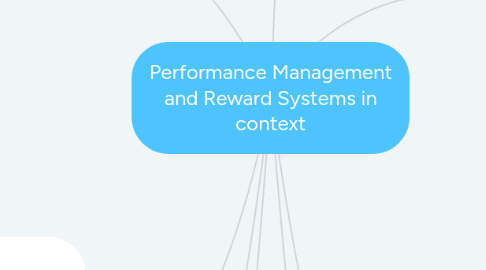
1. 3. Disadvantages/ danger of poorly implemented PM systems
1.1. Affecting to Employee
1.1.1. Lowered self-esteem
1.1.2. Damaged relationship
1.1.3. Decreased motivation to perform
1.1.4. Employee burnout and job dissatisfaction
1.1.5. Increased risk of litigation
1.1.6. Varying and unfair standards and ratings
1.1.7. Unclear rating system
1.2. Affecting to manager
1.2.1. Use of misleading information
1.3. Affecting to organization
1.3.1. Increased turnover
1.3.2. Wasted time and money
1.3.3. Unjustified demands on managers' and employees' resources
1.3.4. Emerging biases
2. 4. Reward System: The set of mechanism for distributing both tangible and intangible returns as part of an employment relationship
2.1. Tangible
2.1.1. Base pay
2.1.2. Cost of living adjustment and contingent pay
2.1.3. Short-term incentives
2.1.4. Long-term incentives
2.2. Intangible
2.2.1. Income protection
2.2.2. Work/life focus
2.2.3. Allowances
2.2.4. Relational Returns
2.3. Degree of Dependency
2.4. Relationship with organization
3. 5. Aims and role of PM systems
3.1. Strategic purpose
3.1.1. Linking employee activities with company's goal
3.2. Administrative purpose
3.2.1. Produce information (promotion, termination)
3.3. Informational purpose
3.3.1. Enable employee to learn about their performance
3.4. Developmental purpose
3.4.1. Allow people to learn about their strengths and weaknesses
3.5. Organizational maintenance purpose
3.5.1. Providing information to be used in workforce planning
3.6. Documentational purpose
3.6.1. Allowing organization to collect useful information that can be used for several documentation purpose
4. 7. Integration with other HR & Development activities
4.1. Key component of talent management
4.1.1. Allowing for assessing the current and making prediction about future needs both at individual and organizational levels
4.1.1.1. Implementing successful performance management system is as requirement for the successful implementation of other HR functions
5. 1. Definition of PM
5.1. Continuous process:
5.1.1. A never ending process of setting goals and objectives, observing performance, giving and receiving ongoing coaching and feed back.
5.2. Alignment with strategic goals:
5.2.1. Creating a direct link between employee performance and organizational goals, making the employees contribution to the organization explicit.
6. 2. The PM contribution
6.1. Affecting to employees
6.1.1. Motivation to perform is increased
6.1.2. Self-esteem is increased
6.1.3. The definitions of job and criteria are clarified
6.1.4. Self-insight and development are enhanced
6.1.5. Administrative actions are more fair and appropriate
6.1.6. Employees become more competent
6.1.7. Employee misconduct is minimized
6.1.8. Voice behavior is encouraged
6.2. Affecting to manager
6.2.1. Managers gain insight about subordinates
6.2.2. There is better and more timely differentiation between good and poor performers
6.2.3. Supervisor's views of performance are communicated more clearly
6.2.4. Employee engagement is enhanced
6.3. Affecting to the organizaiton
6.3.1. Organizational goals are made clear
6.3.2. There is better protection from lawsuits
6.3.3. Organizational change is facilitated
6.3.4. Motivation, commitment, and intentions to stay in the organization are enhanced
7. 6. Characteristics of an Ideal PM system
7.1. Strategic congruence
7.2. Context congruence
7.3. Thoroughness
7.4. Practicality
7.5. Meaningfulness
7.6. Specificity
7.7. Identification of effective and ineffective performance
7.8. Reliability
7.9. Validity
7.10. Acceptability and fairness
7.11. inclusiveness
7.12. Openness
7.13. Correctability
7.14. Standardization
7.15. Ethicality
8. 8. Performance management between VietNam & Japan
8.1. Viet Nam
8.1.1. Doing evaluation based on political affiliations, seniority and harmonious relations
8.1.2. Focusing on the actual job responsibilities of the employees
8.1.3. In history employer only focused on accuracy company's benefits
8.2. Japan
8.2.1. heavily influence by salary and promotion => Salary is always affected by ages and seniority
8.2.2. Employees in japan are evaluated on skills overall performances and attitude
8.2.3. Trying to adapt the American way of evaluating

